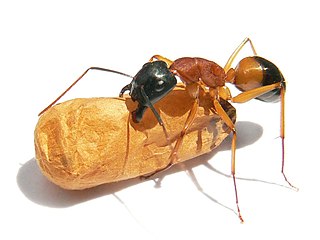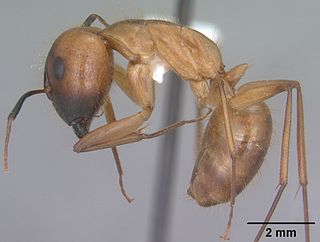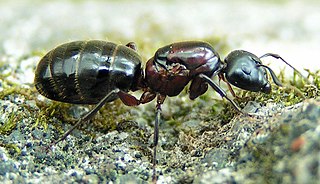Autothysis or suicidal altruism is the process where an animal destroys itself via an internal rupturing or explosion of an organ which ruptures the skin. The term was proposed by Ulrich Maschwitz and Eleonore Maschwitz in 1974 to describe the defensive mechanism of Colobopsis saundersi, a species of ant. It is caused by a contraction of muscles around a large gland that leads to the breaking of the gland wall. Some termites release a sticky secretion by rupturing a gland near the skin of their neck, producing a tar effect in defense against ants.

Carpenter ants are large ants indigenous to many forested parts of the world.

Colobopsis saundersi, also called the Malaysian exploding ant, is a species of ant found in Malaysia and Brunei, belonging to the genus Colobopsis. A worker can explode suicidally and aggressively as an ultimate act of defense, an ability it has in common with several other species in this genus and a few other insects. The ant has an enormously enlarged mandibular gland, many times the size of other ants, which produces adhesive secretions for defense. According to a 2018 study, this species forms a species complex and is probably related to C. explodens, which is part of the C. cylindrica group.

The banded sugar ant, also known as the sugar ant, is a species of ant native to Australia. A member of the genus Camponotus in the subfamily Formicinae, it was described by German entomologist Wilhelm Ferdinand Erichson in 1842. Its common name refers to the ant's liking for sugar and sweet food, as well as the distinctive orange-brown band that wraps around its gaster.

Monomorium is a genus of ants in the subfamily Myrmicinae. As of 2013 it contains about 396 species. It is distributed around the world, with many species native to the Old World tropics. It is considered to be "one of the more important groups of ants," considering its widespread distribution, its diversity, and its variety of morphological and biological characteristics. It also includes several familiar pest species, such as the pharaoh ant and the flower ant.

Myrmecophila is a genus of plants belonging to the family Orchidaceae. It is native to southern Mexico, Central America, the West Indies and Venezuela.
Roy R. Snelling was an internationally renowned American entomologist who studied Hymenoptera, mainly ants, wasps and bees. He was the emeritus collections manager at the Natural History Museum of Los Angeles County where he worked for over 30 years, joining the museum in 1963 and retiring in 1993. He dedicated his professional life to making insect biodiversity better known and appreciated.

Camponotus nearcticus, commonly named smaller carpenter ant, is a relatively small carpenter ant. Its appearance is similar to Lasius niger, commonly named the black garden ant. The ant is a household pest.

Camponotus festinatus is a species of carpenter ant that is typically found in the Southwestern United States and northern reaches of Mexico. It is most commonly found around Tucson, Arizona. It lives in the semi-dead branches of palo verde trees found in the area. Camponotus festinatus is an exclusively liquid feeder. These ants can only feed on sap from trees or the juices of a deceased animal. Like most ants, their diet is primarily sugar with some protein. Camponotus festinatus ants are not known to be aggressive except towards other ants. Soldiers will prefer to run from humans rather than be aggressive. In principle, these ants can bite with their mandibles. However, as carpenter ants like these are formicines, they have no functional sting. Instead of stinging, they can use an acidopore to spray formic acid.

Blochmannia is a genus of symbiotic bacteria found in carpenter ants and their allies in the tribe Camponotini. As of 2014, Blochmannia has been discovered in the guts of over 60 species across 6 genera within the Camponotini, and is predicted to be pervasive throughout the tribe. Blochmannia was first discovered by zoologist Friedrich Blochmann in 1887, who described "bacteria-like structures" in the ovaries and midgut of Camponotus ligniperdus in 1887. In 2000, Candidatus Blochmannia was proposed as its own genus.

Camponotus hyatti is a species of carpenter ant. The species is native to the northern Pacific coast, from Oregon to the Baja California Peninsula. The species is characterized by its five-toothed mandibles and the smooth, shiny appearance of its clypeus, as well as a pronounced metanotal groove, lending the basal surface of the propodeum a distinct convex appearance. It commonly nests in sagebrush, Yucca, manzanita, and oak.

Camponotus floridanus, or Florida carpenter ant, is a species of ant in the genus Camponotus. First described as Formica floridana by Buckley in 1866, the species was moved to Camponotus by Mayr in 1886. The ant is widespread in Florida and occurs as far north as North Carolina and as far west as Mississippi.

The black-headed sugar ant, also known as the brown sugar ant, is a species of Formicinae ant endemic to Australia. Found throughout most states, the species is a member of the genus Camponotus, a cosmopolitan genus of ants commonly known as carpenter ants. It was formally described and named by British entomologist Frederick Smith in 1858. These ants are characterised by their black head, reddish-brown mesosoma and black gaster, which can change in colour.

Camponotus mina is a species of carpenter ant native to large parts of northern Mexico, California, Arizona, Texas, and New Mexico, and possibly Wyoming, South Dakota, and Minnesota.

Camponotus novaeboracensis, the New York carpenter ant, is a species of carpenter ant native to the United States, Canada, possibly found in Costa Rica, Malaysia, and invasive in Bermuda.

Camponotus dumetorum is a species of carpenter ant native to North America. They are related to other species from the subgenus Tanaemyrmex in western North America such as C. semitestaceus and C. vicinus. C. dumetorum are primarily nocturnal and form nests underground. Like other select ant species native to California, their populations have been displaced with the introduction of Argentine ants.

Colobopsis is a genus of ant in the subfamily Formicinae. This genus was first described in 1861 by Mayr and contains 95 species. The type species is Colobopsis truncata.

Camponotus absquatulator is a species of carpenter ant native to California, Nevada, and Baja California. This species was separated from the Camponotus festinatus complex in 2006 by Roy Snelling.

Camponotus microps is a species of carpenter ant native to Arizona, New Mexico, Sonora, Queretaro, and Guanajuato. This species was separated from the Camponotus festinatus complex in 2006 by Roy Snelling.

Camponotus pudorosus is a species of carpenter ant native to Arizona, New Mexico, Colorado, Mexico, and Guatemala. Originally described in 1925 by Carlo Emery and synonymized by W. W. Kempf in 1972, the species was revived in 2006 from the Camponotus festinatus complex by Roy Snelling.


















